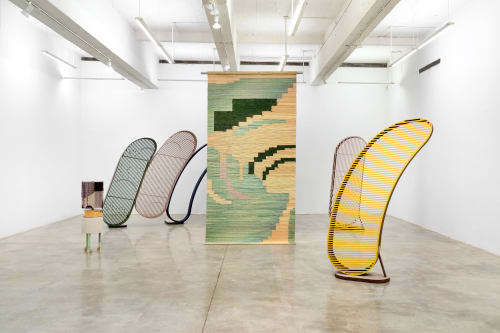Suki Seokyeong Kang’s current exhibition (on view through June 15, 2024) features 25 works from the last decade. Made from wood, painted steel, paper, silk, ink, yarn, thread, and chain, Kang’s three-dimensional forms and wall works often resemble meditative maps, magpie nests, jeweled canopies, or moveable furniture. Although Kang has created performances and videos in the past, none are on view in this show titled only with the artist’s name. Yet, like the elements of a stage set, her sculptures allude to use and movement.
Mat 61 x 81 #23-77 and Mat 61 x 81 #23-78 (both 2023), a pair of wall-mounted works in the first gallery, feature dominant black lines approximating choreographic notations. Two stick figures—one per mat—seem to squat down, facing each other. If these are indeed diagrams, the line work could indicate that, while squatting, interested dancers should reach toward the ground in front of them and then raise their arms. Both mats are enclosed in steel containers reminiscent of decorative door grates, an encasement that could be read as a cage or signal a protective impulse.
Kang, who trained in classical painting, honors and reimagines creations from Korea’s Joseon Dynasty, which lasted until 1897. The 500 years of the dynasty’s rule were transformative, seeing the development of musical notation, universal literacy, and a highly refined royal court culture in which meticulously measured dances like Chunaengmu (Dance of the Spring Oriole) were popular. Commissioned by a prince to celebrate his mother’s birthday, Chunaengmu requires a dancer (usually a woman) to keep to the confines of a small decorative mat and use only limited movements to imitate a bird. In 2018, Kang told Ocula Magazine that the original choreography required a dancer to clasp her hands behind her back, presumably raise her head, and smile at the assembled royals. Court dancers, especially women, weren’t typically allowed to show such informality or pride. Chunaengmu dancers may have been confined to their mats like birds in cages, but as Kang sees it, they also enacted singular, bold gestures that defied status and allowed them to look royalty right in the eye.
Perhaps a similar subversive or even defiant logic is at play in the four sculptures that make up Kang’s Columns-Group of 4 Sculptures (2020–22). The metal forms, positioned in the second gallery, look more like full-length mirrors, bananas, or sausages than proper architectural supports. Architecture—commonly used to convey status, wealth, and power—here is rebuked and replaced with humanity and humor. In one of the four sculptures, three phallic forms are sandwiched together, bolted side to side like drunks leaning against each other for support. Similarly, a group of freestanding mountains recalls the austere summits lovingly rendered in Joseon Dynasty ink paintings. Kang’s versions, however, are human height, brightly colored, and joyfully decked out with thread and chain. There’s one for each season. Mountain—spring #21-01 (2021) is pink, decorated in lace, and, at just under five feet tall, easily approachable. Looking at Kang’s work, mountains feel momentarily less imposing. And maybe we are better for it.
Kang’s practice is characterized by classical artistry, reverence, and some welcome irreverence, too. She humbles powerful elements and edifices and, in looking at the past, acknowledges that great advances often came in times full of significant restrictions. How different will the future look? Political pundits called the 2022 presidential election in Korea a gender war. The current president, Yoon Suk Yeol, rode into office on a right-wing agenda that included proposals to remove protections for women and families. It’s unlikely that Yoon will be president for the next term, but unchecked, the powerful will reach for whatever they think is best for them. As small, fallible, and wobbly as all of us are, it’s still our responsibility to put our hands behind our backs and look power right in the eye once in a while. It’s the least we can do.
—Marcus Civin


